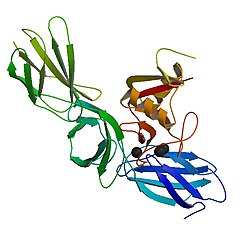Proteoglycan

Proteoglycans are
Types
Proteoglycans are categorized by their relative size (large and small) and the nature of their glycosaminoglycan chains.[3] Types include:
| Type | Glycosaminoglycans (GAGs) | Small proteoglycans | Large proteoglycans |
|---|---|---|---|
| chondroitin sulfate/dermatan sulfate | decorin, 36 kDa biglycan, 38 kDa |
aggrecan, 220 kDa, the major proteoglycan in cartilage | |
Heparan sulfate proteoglycan (HSPGs) |
heparan sulfate/chondroitin sulfate | testican, 44 kDa | betaglycan, >300 kDa , >500 kDa
agrin |
| Chondroitin sulfate proteoglycan (CSPGs) |
chondroitin sulfate | bikunin , 25 kDa
|
neurocan, 136 kDa |
| Keratan sulfate proteoglycan | keratan sulfate | fibromodulin, 42 kDa lumican, 38 kDa |
Certain members are considered members of the "small leucine-rich proteoglycan family" (SLRP).[4] These include decorin, biglycan, fibromodulin and lumican.
Function
Proteoglycans are a major component of the animal
Synthesis
The protein component of proteoglycans is synthesized by
Clinical significance
An inability to break down the proteoglycans is characteristic of a group of
Distinction between proteoglycans and glycoproteins
Quoting from recommendations for IUPAC:[9]
A glycoprotein is a compound containing carbohydrate (or glycan) covalently linked to protein. The carbohydrate may be in the form of a monosaccharide, disaccharide(s), oligosaccharide(s), polysaccharide(s), or their derivatives (e.g. sulfo- or phospho-substituted). One, a few, or many carbohydrate units may be present. Proteoglycans are a subclass of glycoproteins in which the carbohydrate units are polysaccharides that contain amino sugars. Such polysaccharides are also known as glycosaminoglycans.
References
- ^ Proteoglycans at the U.S. National Library of Medicine Medical Subject Headings (MeSH)
- ISBN 978-0-323-02942-1. Retrieved 6 February 2011.
- PMID 25701227.
- ISBN 978-3-527-30888-0. Retrieved 6 February 2011.
- ISBN 978-1-118-91840-1.
- PMID 28270211.
- PMID 24392029.
- S2CID 10165577.
- ^ "Nomenclature of glycoproteins, glycopeptides and peptidoglycans, Recommendations 1985". www.qmul.ac.uk. Retrieved 16 March 2021.
